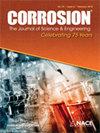The Impact of Trisodium Phosphate on Chloride-Driven Under Deposit Corrosion in Steam Generators
IF 1.3
4区 材料科学
Q4 MATERIALS SCIENCE, MULTIDISCIPLINARY
引用次数: 0
Abstract
Carbon or low alloy steel tubes in steam generators (or boilers) are potentially vulnerable to Under Deposit Corrosion (UDC), arising from the formation of porous magnetite deposits on the waterside heat transfer surfaces. Beneath these deposits, ‘wick-boiling’ causes concentration of contaminants (such as chlorides), which eventually leads to rapid corrosion. In this work, the corrosion of carbon steel has been investigated in hot acid chloride solutions that simulate the concentrated local environments formed during UDC. Tri-Sodium Phosphate (TSP) is sometimes dosed into boilers for pH control. This work has shown that TSP addition such that the phosphate concentration equals the chloride concentration dramatically reduces the corrosion rate in these simulated environments from > 20 to < 0.1 mm/yr. Additionally, a model of wick-boiling beneath deposits has been used to analyze the concentration of chlorides and phosphates during the initiation stages of UDC, suggesting that dosing of only 100 ppb of TSP into bulk boiler water should be sufficient to increase the critical deposit thickness (required for UDC) by > 100 μm across a wide range of operational scenarios.磷酸三钠对蒸汽发生器氯化物驱动下沉积腐蚀的影响
蒸汽发生器(或锅炉)中的碳或低合金钢管可能容易受到沉积下腐蚀(UDC),这是由水边传热表面形成的多孔磁铁矿沉积物引起的。在这些沉积物下面,“芯沸腾”会引起污染物(如氯化物)的集中,最终导致快速腐蚀。在这项工作中,研究了碳钢在热氯化酸溶液中的腐蚀,模拟了UDC过程中形成的集中局部环境。有时在锅炉中加入三磷酸钠(TSP)来控制pH值。这项工作表明,加入TSP使磷酸盐浓度等于氯化物浓度,可以显著降低这些模拟环境中的腐蚀速率。20到<0.1毫米/年。此外,在UDC的起始阶段,使用沉积物下的芯沸腾模型来分析氯化物和磷酸盐的浓度,表明仅向锅炉水中添加100 ppb的TSP就足以使临界沉积物厚度(UDC所需的)增加100 ppb;100 μm,适用于各种操作场景。
本文章由计算机程序翻译,如有差异,请以英文原文为准。
求助全文
约1分钟内获得全文
求助全文
来源期刊

Corrosion
MATERIALS SCIENCE, MULTIDISCIPLINARY-METALLURGY & METALLURGICAL ENGINEERING
CiteScore
2.80
自引率
12.50%
发文量
97
审稿时长
3 months
期刊介绍:
CORROSION is the premier research journal featuring peer-reviewed technical articles from the world’s top researchers and provides a permanent record of progress in the science and technology of corrosion prevention and control. The scope of the journal includes the latest developments in areas of corrosion metallurgy, mechanisms, predictors, cracking (sulfide stress, stress corrosion, hydrogen-induced), passivation, and CO2 corrosion.
70+ years and over 7,100 peer-reviewed articles with advances in corrosion science and engineering have been published in CORROSION. The journal publishes seven article types – original articles, invited critical reviews, technical notes, corrosion communications fast-tracked for rapid publication, special research topic issues, research letters of yearly annual conference student poster sessions, and scientific investigations of field corrosion processes. CORROSION, the Journal of Science and Engineering, serves as an important communication platform for academics, researchers, technical libraries, and universities.
Articles considered for CORROSION should have significant permanent value and should accomplish at least one of the following objectives:
• Contribute awareness of corrosion phenomena,
• Advance understanding of fundamental process, and/or
• Further the knowledge of techniques and practices used to reduce corrosion.
 求助内容:
求助内容: 应助结果提醒方式:
应助结果提醒方式:


